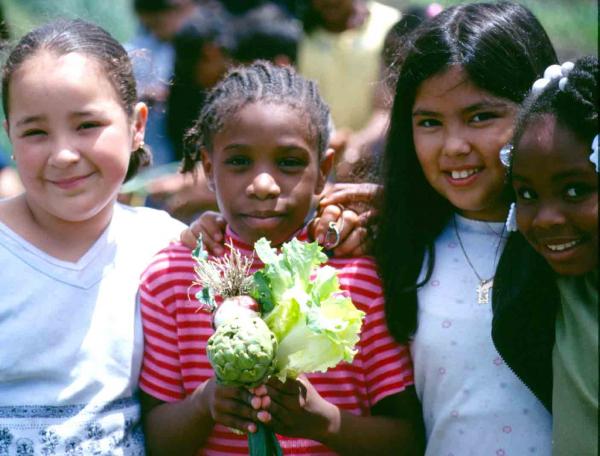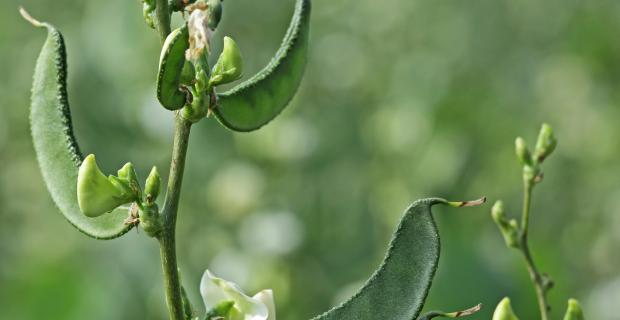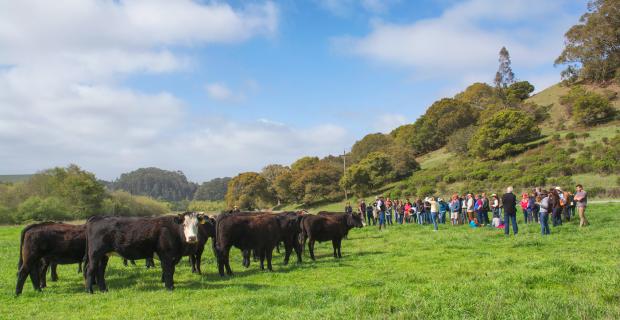Food Systems, Climate Change, and Ecological Education

As Michael Pollan reports, awareness of the link between food systems and climate change is growing. Several organizations are devoted to investigating and acting on these connections. Nevertheless, public awareness of the importance of this relationship is not widespread, and it does not figure prominently in most K–12 school curricula.
Even people who accept that anthropogenic climate change is occurring are more likely to think first about energy — "green" buildings and energy conservation or solar panels and wind farms versus fossil fuels. Or they focus on transportation — gas-guzzlers versus hybrids, or bicycles and public transportation versus single-occupancy vehicles. And so on.
Most people are less likely to think first about the dinner on their plate, but the connections are deep and wide-ranging between climate change and food systems — the food choices we make; the ways we grow, raise, transport, process, store, prepare, and serve food; how we manage food waste. Many researchers attribute about a third of human-generated global greenhouse gas emissions to activities somewhere in the food chain.1 Depending on what is counted, some estimates are as high as 50 percent2 or more.3
Ecological education
The juncture of food systems and climate change is a compelling topic for ecological education.
First, it is as basic to sustainable living as any topic. Food is essential to survival, and food systems and the people who depend on them are profoundly threatened by climate change.4
Second, this issue can only be understood ecologically. It requires thinking systemically about natural and social networks. It offers a real world context — with real world consequences — for teaching and learning about key ecological principles and processes, including cycles, flows, interdependence, diversity, development, and dynamic balance. These, in turn, overlap with many of the crosscutting concepts of the Next Generation Science Standards, including patterns; cause and effect; systems and system models; energy and matter flows, cycles, and conservation; stability and change.
Third, connecting food systems and climate change entails describing links between this contemporary environmental concern and the daily experiences and practices of students and schools, from learning in the garden to procuring, preparing, and providing meals and reducing food waste. It provides an opportunity to engage with the Center's mission, as stated in our strategic plan: "We advance a model of K–12 ecological education that encourages students to experience and understand how nature sustains life and how to live accordingly."
It is a topic that can be approached from the perspective of the Center for Ecoliteracy's Smart by Nature Guiding Principles:
- Nature is our teacher
- Sustainability is a community practice
- The real world is the optimal learning environment
- Sustainable living is rooted in a deep knowledge of place
Fourth, food systems are particularly relevant to an ecological discussion of climate change because of the opportunity (the necessity, in fact) of solving for pattern in support of the health of whole human and natural ecosystems. Food systems create possibilities, in Wendell Berry's words, for solutions that cause a ramifying series of solutions. In particular, the adoption of a variety of agricultural practices (variously called "climate-friendly agriculture," "agroecology," or sometimes "organic agriculture") can contribute to combatting climate change while simultaneously supporting increased food security, replenishment of soil, restoration of degraded resources, protection of ecosystem services and biodiversity, retention of water, improved finances of farmers, and the well-being of farm communities.
Fifth, of all the strategies proposed for addressing climate change, strategies based on practices in the food system offer some of the greatest promise of removing carbon from the atmosphere. The most enthusiastic proponents, such as the Rodale Institute, assert that the equivalent of more than 100 percent of current annual CO2 emissions could be sequestered through "regenerative organic agriculture," resulting in a reversal of the greenhouse effect.5
At the same time, some people point to obstacles or worry that strategies such as soil-carbon offset markets may create incentives for "soil grabbing" by industrial interests more concerned with profit than in growing food or sustaining communities in Africa, Brazil, and elsewhere.6
A program of ecological education should familiarize students with such proposals and help them identify tools and resources for assessing them.
Our investigation to date suggests that the topic of food systems and climate change is not being widely addressed in K–12 education. We can hypothesize several reasons. Few resources are available to help teachers present this material. As noted above, food systems have not been featured as much in climate change discussions as might be expected in light of their importance. A Worldwatch Institute research paper observes that most climate leaders come out of the atmospheric science or energy sectors. Some, in fact, may even be reluctant to consider agriculture-based solutions out of fear that that would distract attention and resources from efforts to transform the energy economy or would take industrial-emitter countries "off the hook."7
Climate change, and the threats it presents, is a topic that can be difficult for students and their teachers. This increases the need to identify and devise ways to address the topic while being attentive to its emotional, social, cognitive, and practical dimensions. The issues are complex and politically charged, which is all the more reason for helping students, who are and will be citizens, to understand them and imagine how to act accordingly.
1. Anna Lappé, Diet for a Hot Planet (Bloomsbury, 2010), p. 11.
2. Center for Food Safety, Food & Climate: Connecting the Dots, Choosing the Way Forward, p.3. centerforfoodsafety.org/files/foodclimate_51242.pdf.
3. Ulrich Hoffman, ed. Trade and Environment Review 2013: Wake Up before It's Too Late (2013, United Nations Conference on Trade and Development). p. 20.
4. The list of impacts that climate disruptions can have — and are already having — is long. To name just a few of the predicted effects: damage to food production from extreme weather (droughts, floods, heat waves, heavy rains, unseasonable frosts); proliferation of pathogens, parasites, and weeds; reduction of optimal conditions for reproductive development; water scarcity + longer growing seasons leading to increasing demand for water; alteration of pollinator activity; reduction of winter chill hours needed for proper setting of fruits and nuts; rising temperatures requiring more refrigeration, which causes emission of more greenhouse gases, which raises temperatures; loss of cropland; interruption of food distribution infrastructure; loss of nutritional value of food crops; increase in wildfires; increased erosion; decreased biodiversity; decrease in nutritional value of crops; loss of livelihoods for agricultural workers; crop shortages + volatility in retail food prices + lost employment leading to more poverty and more malnutrition (an Oxfam America report's estimate: 25 million more malnourished children and 50 million more hungry people by 2050).
5. Rodale Institute, Regenerative Organic Agriculture and Climate Change: A Down-to Earth Solution to Global Warming. (2014), executive summary. rodaleinstitute.org/assets/RegenOrgAgricultureAndClimateChange_20140418.pdf.
6. Fred Pearce, Can "Climate-Smart" Agriculture Help Both Africa and the Planet? Environmenent360 (Yale School of Forestry & Environmental Studies 2011). e360.yale.edu/feature/after_durban_can_climate¬smart_farming_help_africa_and_the_planet/2477/.
7. Sara J. Scherr and Sajal Sthapit, Worldwatch Report 179: Mitigating Climate Change through Food and Land Use, p. 10 (Worldwatch Institute, 2009).




